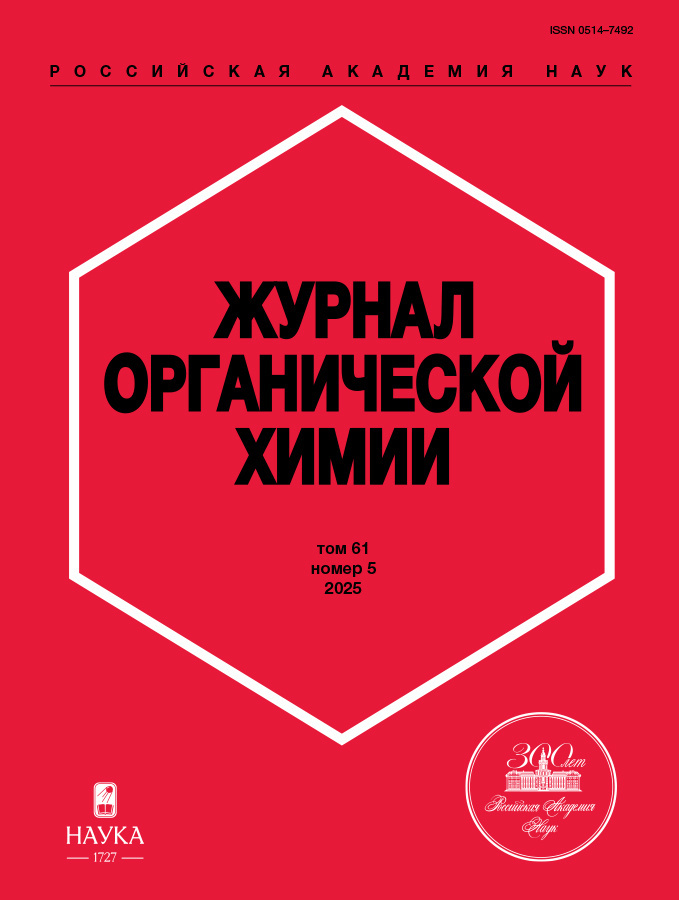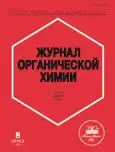Theoretical Study by DFT Method of the Arbuzov Reaction Mechanism Between Ethyl Halogenides and Trimethoxyphosphine
- Authors: Filippova A.V.1, Syzgantseva M.A.2, Galitsin A.P.1, Syzgantseva O.A.1
-
Affiliations:
- Lomonosov Moscow State University
- Mendeleev University of Chemical Technology
- Issue: Vol 60, No 8 (2024)
- Pages: 57-66
- Section: Articles
- URL: https://gynecology.orscience.ru/0514-7492/article/view/676690
- DOI: https://doi.org/10.31857/S0514749224080086
- EDN: https://elibrary.ru/QZYEMW
- ID: 676690
Cite item
Abstract
The mechanism of the reaction between ethyl chloride or ethyl bromide with trimethoxyphosphine in a non-polar (ε = 1) and polar medium (methanol, ε = 32.7) was studied within the density functional theory (DFT) using MOLPRO program. It was shown that the reaction occurs in 2 stages: first, a nucleophilic attack of the carbon atom by phosphorus occurs, followed by the interaction of methyl of one of the methoxy groups with the halide. The limiting stage in all cases is the second stage of the reaction, the barrier of which is approximately 1.5 times higher than the barrier of the first. The reaction barriers are lower for the reaction of ethyl bromide, while the stabilization energies of the intermediate complexes and products are almost the same for chloride and bromide. Temperature in general has little effect on the reaction profile, with the exception of entropic destabilization of the initial complex. At the same time, the usage of a polar solvent accelerates the reaction process, lowering the barriers and stabilizing the intermediates, and can be recommended for carrying out the reaction.
Full Text
About the authors
A. V. Filippova
Lomonosov Moscow State University
Email: osyzgantseva@gmail.com
Russian Federation, Moscow
M. A. Syzgantseva
Mendeleev University of Chemical Technology
Email: osyzgantseva@gmail.com
ORCID iD: 0000-0001-8070-104X
Russian Federation, Moscow
A. P. Galitsin
Lomonosov Moscow State University
Email: osyzgantseva@gmail.com
Russian Federation, Moscow
O. A. Syzgantseva
Lomonosov Moscow State University
Author for correspondence.
Email: osyzgantseva@gmail.com
ORCID iD: 0000-0002-0270-4621
Russian Federation, Moscow
References
- Glueck D.S., Top. Organomet. Chem., 2010, 31, 65–100. doi: 10.1007/978-3-642-12073-2_4
- Abakumov G.A., Piskunov A.V., Bochkarev M.N., Dzhemilev U.M., Fedushkin I.L., Egorov M.P., Ananikov V.P., Averin A.D., Beletskaya I.P., Sinyashin O.G., Budnikova Yu.H., Burilov A.R., Gordeev E.G., Muzafarov A.M., Karasik A.A., Trofimov B.A., Cherkasov V.K., Trifonov A.A., Mironov V.F., Andreev M.V., Syroeshkin M.A., Gusarova N.K., Eremin D.B., Dyakonov V.A., Vereshchagin A.N., Jouikov V.V., Anisimov A.A., Arzumanyan A.V., Kononevich Yu.N., Temnikov M.N., Storozhenko P.A., Shcherbakova G.I., Amosova S.V., Potapov V.A., Shur V.B., Burlakov V.V., Bogdanov V.S., Russ. Chem. Rev., 2018, 87, 393. doi: 10.1070/RCR4795
- Beletskaya I.P., Kazankova M.A., Russ. J. Org. Chem., 2002, 38, 1391–1430. doi: 10.1023/A:1022685801622
- Schwan A.L., Chem. Soc, Rev., 2004, 33, 218–224. doi: 10.1039/B307538A
- Selikhov A.N., Plankin G.S., Cherkasov A.V., Shavyrin A.S., Louyriac E., Maron L., Trifonov A.A., Inorg. Chem., 2019, 58, 5325–5334. doi: 10.1021/acs.inorgchem.9b00490
- Потапов Р., Химия, изменившая мир, Издательские решения, 2018.
- Кузнецова Е.М., Чмиль В.Д., Современные проблемы токсикологии, 2010, 1, 87–95. ISSN 1609-0446
- Schwartz D., Berger S., Heinzelmann E., Muschko K., Welzel K., Wohlleben W., Appl. Environ. Microbiol., 2004, 70, 7093–7102. doi: 10.1128/AEM.70.12.7093-7102.2004
- Реутов О.А., Курц А.Л., Бутин К.П., Органическая химия в 4-х частях, Москва: Лаборатория знаний, 2022.
- Maryanoff B.E., Reitz A.B., Chem. Rev., 1989, 89, 863–927. doi: 10.1021/cr00094a007
- Byrne P.A., Gilheany D.G., Chem. Soc. Rev., 2013, 42, 6670–6696. doi: 10.1039/c3cs60105f
- Wadsworth W., Org. React., 1977, 25, 73–253. doi: 10.1002/0471264180.or025.025
- Horner L., Hoffmann H.M.R., Wippel H.G., Ber., 1958, 91, 61–63. doi: 10.1002/cber.19580910113
- Horner L., Hoffmann H.M.R., Wippel H.G., Klahre G., Ber., 1959, 92, 2499–2505. doi: 10.1002/cber.19590921017
- Wadsworth W.S., Jr., Emmons W.D., J. Am. Chem. Soc., 1961, 83, 1733. doi: 10.1021/ja01468a042
- Wadsworth W.S., Jr., Emmons W.D., Org. Synth., 1973, 5, 547. doi: 10.15227/orgsyn.045.0044
- Wadsworth W.S., Jr., Emmons W.D., Org. Synth., 1965, 45, 44. doi: 10.15227/orgsyn.045.0044
- Ferao A.E., J. Phys. Chem., 2017, 121, 6517–6522. doi: 10.1021/acs.jpca.7b06262
- Michaelis A., Kaehne R., Ber. Dtsch. Chem. Ges., 1898, 31, 1048–1055. doi: 10.1002/cber.189803101190
- Toupy T., Monbaliu J.-C.M., Org. Process Res. Dev., 2022, 26, 467–478. doi: 10.1021/acs.oprd.1c00472
- Becke A.D., 1988, 38, 3098–3100. doi: 10.1103/physreva.38.3098
- Lee C.T., Yang W.T., Parr R.G., Phys. Rev., 1988, 37, 785–789. doi: 10.1103/physrevb.37.785
- Vosko S.H., Wilk L., Nusair M., Can. J. Phys., 1980, 58, 1200–1211. doi: 10.1139/P80-159
- Klamt A., Schüürmann G., J. Chem. Soc., Perkin Trans. II, 1993, 799–805. doi: 10.1039/P29930000799
- Werner H.-J., Knowles P.J., Knizia G., Manby F.R., Schütz M., Wiley Interdiscip. Rev. Comput. Mol. Sci., 2012, 2, 242–253. doi: 10.1002/wcms.82
- Dunning T., J. Chem. Phys., 1989, 90, 1007. doi: 10.1063/1.456153
- Voevodin V.V., Antonov A.S., Nikitenko D.A., Shvets P.A., Sobolev S.I., Sidorov I.Y., Stefanov K.S., Voevodin V.V., Zhumatiy S.A., Supercomput. Front. Innov., 2019, 6, 4–11. doi: 10.14529/jsfi190201
Supplementary files















